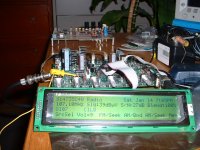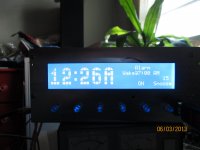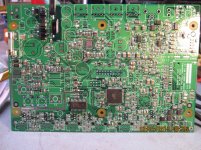Correct! I just went through all of the calculations and was updating my post when you posted this.
Actually, you're both right. I missed the "K". Both resistors as built are 47R. Must be my poor handwriting for Dave.
Yes sorry of that I'm sure. I just have recently used Prasis gerbers and he was fresh in my mind.
Prasis is very good. But we also have many members who have a good feel for laying out PCBs too.
No problem.
-Chris
No problem.
-Chris
Being good at using PCB software and actually understanding circuitry layout requirements are two different things.
😉
Patrick
😉
Patrick
Anatech, thanks for sharing.
Does it need matched transistors for the diamond like stage after the oap ?
Does it need matched transistors for the diamond like stage after the oap ?
Hi diyiggy,
No, but performance and DC offset are generally better if the transistors are matched. You don't have to go crazy matching these as they are complimentary.
Hi Patrick,
So true!
No, but performance and DC offset are generally better if the transistors are matched. You don't have to go crazy matching these as they are complimentary.
Hi Patrick,
So true!
Thanks Anatech. This board should make something very great with a good little headphone circuitry close in a standalone box 🙂 and a R-Core traffo to feed them.
Yes, I think it will do very well.
The diamond buffer is an amazing building block and can be used in countless ways, more with slight modifications. It is inherently a low distortion circuit.
The diamond buffer is an amazing building block and can be used in countless ways, more with slight modifications. It is inherently a low distortion circuit.
Just goes to prove that ultra low thd is not that important imo. But I really would say to compare it to a Opa1656 and then determine if it is worth the effort and cost. If it is just a fun excerise in pcb design, do it up in kicad so folks can learn
Hi Rick,
Well, its a fun project and really high performance from a simple discrete circuit that people can build. There is that fun factor, and the power supply will figure into the performance.
Heck, an OPA2134 would beat that performance most probably. But it isn't fun just poking an op amp into a circuit. Mind you, folks can still mess that PCB up.
I actually prefer this project over using an op amp. Output current is higher I think. Could go to higher voltage with some part changes. Can also be used for a good headphone amp.
This has very low distortion across the board, and I think that is important. I would still build a crystal radio kit, or a clock kit.
-Chris
Well, its a fun project and really high performance from a simple discrete circuit that people can build. There is that fun factor, and the power supply will figure into the performance.
Heck, an OPA2134 would beat that performance most probably. But it isn't fun just poking an op amp into a circuit. Mind you, folks can still mess that PCB up.
I actually prefer this project over using an op amp. Output current is higher I think. Could go to higher voltage with some part changes. Can also be used for a good headphone amp.
This has very low distortion across the board, and I think that is important. I would still build a crystal radio kit, or a clock kit.
-Chris
ultra low thd is not that important
THD is a relatively irrelavant specification. All the important info is in the spectrum before your collapes that into a single number.
dave
I built a radio and a clock a few back now, plus a few extras 🙂 Mom loves it, she has temp, humdity, BarometerI would still build a crystal radio kit, or a clock kit.
On my to do list is to build Bob Cordell's MM amp that is shown in his VinylTrak design
Jan Didden LinearAudio Volume 4
Figure 6 shows the MM input amplifier and 75us equalization circuit. The amplifier is a discrete differential
JFET-input, folded cascode design without negative feedback and without source degeneration.
The 2mA tail current source is cascoded, with the bases of Q3 and Q4 AC-referenced to
ground and the negative rail, respectively, for best PSRR. The JFET drains are cascoded prior to their
connection to the folded cascode emitters, making this a double folded cascode circuit. This improves
power supply rejection by isolating the rail-referenced folded cascode emitters from the
ground-referenced JFET drains. The VAS includes a Wilson current mirror that provides superior PSRR.
The output stage is a bootstrapped diamond buffer, which provides exceptional linearity and a very
light load to the cascoded VAS node.
Without the 75us EQ, the amplifier bandwidth is 4MHz and the slew rate is in excess of 200V/us
when driven with a full-amplitude square wave.
Attachments
Last edited:
Hi Rick,
That's a really cool FM radio kit! I really like it. I need something for Music On Hold for my phone system that is small like that, but has memory when the power fails. I like the clock too.
Bob's preamp is also on my build some day list.
Hi Dave,
Yes, single number distortion specs only tell you a tiny amount abut a circuit. The entire spectrum tells you so much more. But you should be looking at the spectrum for THD and IMD. Those can tell you quite a lot about something.
-Chris
That's a really cool FM radio kit! I really like it. I need something for Music On Hold for my phone system that is small like that, but has memory when the power fails. I like the clock too.
Bob's preamp is also on my build some day list.
Hi Dave,
Yes, single number distortion specs only tell you a tiny amount abut a circuit. The entire spectrum tells you so much more. But you should be looking at the spectrum for THD and IMD. Those can tell you quite a lot about something.
-Chris
Yeah it has tons of non-volatile memory, a big super ecap, Atmel xmega MCU.
It is a AM/FM/SW radio, MP3 player, USB codec, RTC, headphone amp, TI class D speaker amp. Maxim discontinued the MAX9729 on me. Only two portable radios like it in the world.
I gave up, got bored of writing code.
If the harmonics are in the noise, I can not see how it could tell you anything useful as far as having a sound signature. Our ears/brains are not FFT analyzers.
It is a AM/FM/SW radio, MP3 player, USB codec, RTC, headphone amp, TI class D speaker amp. Maxim discontinued the MAX9729 on me. Only two portable radios like it in the world.
I gave up, got bored of writing code.
If the harmonics are in the noise, I can not see how it could tell you anything useful as far as having a sound signature. Our ears/brains are not FFT analyzers.
Last edited:
- Home
- Source & Line
- Analog Line Level
- Inexpensive preamp kit on Ebay


